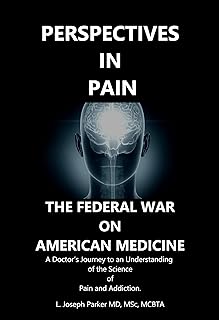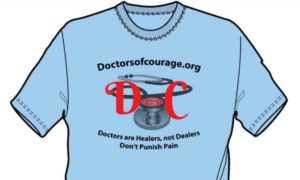Pain management has long been a crucial field of medicine, offering relief to patients suffering from chronic pain, severe injuries, and terminal illnesses. However, the policies, stigma, and regulatory environment created by the U.S. government have transformed this once-respected specialty into one of the most perilous paths for medical professionals to pursue. For years, the government’s response to the opioid crisis has been to criminalize physicians, threaten their livelihoods, and disregard the complexities of pain treatment, all while leaving patients in desperate need of care. The recent tragic story of former NFL player Phillip Adams, who suffered from Chronic Traumatic Encephalopathy (CTE) and took the lives of six people including the life of his doctor, before ending his own, illustrates the destructive intersection of untreated pain, neurological disorders, and a system that penalizes the very doctors who could help.
Phillip Adams played professional football for over two decades, enduring repeated head trauma that ultimately led to a severe case of CTE, a degenerative brain disease commonly seen in former athletes exposed to traumatic brain injuries. Neuropathologists from Boston University revealed that Adams had an “extraordinary amount of CTE pathology in the frontal lobe,” the part of the brain that influences behavior control, judgment, and impulse regulation. This finding linked Adams’ condition to symptoms such as violent impulses, lack of self-control, and aggression, all hallmarks of frontal lobe damage.
CTE cannot be diagnosed in a living patient, the disease only comes to light through postmortem brain examination, making it nearly impossible for individuals like Adams to receive proper treatment for the underlying neurological issues causing their symptoms. Tragically, despite the observable struggles in Adams’ mental health, the U.S. healthcare system, hamstrung by rigid opioid regulations and the fear of professional repercussions, is often unable to help.
Pain management physicians walk a tightrope, they are required to treat their patients’ pain adequately, but many fear that doing so could bring about investigations, suspensions, or even criminal charges. Federal initiatives aimed at combatting the opioid crisis have created an environment where any perceived “over-prescription” or deviation from guidelines can trigger a government crackdown. Unfortunately, this has led to a climate where chronic pain patients, such as those suffering from CTE or other debilitating conditions, often find themselves unable to access effective pain relief.
The Drug Enforcement Administration (DEA) has aggressively pursued physicians who prescribe opioids, resulting in the closure of numerous clinics and pain practices across the country. This approach not only penalizes doctors but also forces patients, often desperate for pain management, into a shadowy realm of under-the-counter drugs, increased suicide rates, and heightened suffering. Pain management doctors, meanwhile, face a dilemma, continue to treat patients and risk federal scrutiny, or practice defensively and risk leaving patients in agony.
The psychological burden on patients who cannot access adequate pain relief is immense, often leading to severe depression, suicidal ideation, and, in some cases, violence. Phillip Adams’ tragic story shines a light on how untreated conditions, exacerbated by a medical system that vilifies pain management, can have devastating consequences. The brain damage caused by CTE drove Adams to irrational and violent behavior, yet those behaviors are often unaddressed or misunderstood, partly because doctors fear providing the treatments that might alleviate some of these symptoms.
Pain specialists often endure harassment, career-ending legal battles, and even imprisonment, adding to the scarcity of medical professionals willing to enter the field. The pathologizing of pain management has resulted in a mass exodus from the specialty, with many doctors abandoning their practices altogether, unable to reconcile the risks with the demands of their patients. Without accessible pain management options, patients suffering from traumatic brain injuries, chronic pain conditions, or degenerative diseases like CTE face a bleak reality.
The criminalization of pain management reflects a broader issue, a medical system governed by fear and suspicion rather than compassion and science. Pain is a legitimate medical issue that requires dedicated care, but doctors are frequently denied the autonomy to provide such care under government scrutiny. While regulating opioids is necessary to combat addiction, the current approach has devastated the field of pain management, driving qualified doctors out and leaving patients without viable treatment options.
Phillip Adams’ case should serve as a wake-up call. Rather than punishing doctors and patients, we need policies that recognize the nuanced challenges of treating chronic pain and the mental health complications that arise from conditions like CTE. If the U.S. government continues to treat pain management as a battleground rather than a medical specialty, stories like Adams’ may become tragically more common. It is high time to shift focus from punitive measures to a supportive framework for those in need of pain relief, or we risk making pain management not only the most dangerous specialty in medicine but a field that ceases to exist altogether.
The Author received an honorable discharge from the U.S. Navy where he utilized regional anesthesia and pain management to treat soldiers injured in combat at Walter Reed Hospital. The Author is passionate about medical research and biotechnological innovation in the fields of 3D printing, tissue engineering and regenerative medicine.


Losing my palliative care dr next year, cant take the gabapentinoids offered so only option I am being left with is to illegally end my life. And so I live my last year…….things have gotten so messed up.
Too bad you haven’t chosen to learn how to heal your diseases. The choice is still there, if you are interested. https://sevenpillarstotalhealth.com/bringing-medicine-to-the-21st-century-intro/
Cato institute
https://www.cato.org/events/pain-refugees-collateral-damage-war-drugs
It is a sham war. Have we seen any victory for patients as a result of this war? None. However we have seen many casualties, dead bodies of patients who committed suicide, doctors being sent to prison and clinics shut down. The prosecutors taking their victory lap through one-sided reporting in the media with their tall claims that are not challenged by the journalists.
But those affected aren’t wanting to learn what will end this atrocity. Can you explain that? We have the answer, but as long as people stick to the propaganda that drugs cause addiction, we will get nowhere.
Everyone in the medical community has to figure out a law to protect patients and providers against criminal ruin. The DEA denies being the culprit that we lose our DEA licenses, which has got to be a lie. It just is ridiculous. Maybe with our new government in 2025 in the White House, God will find us lawyers to be able by a new law to protect our profession. I have also been working on this cause 20 years, to no success. Without a pm provider I go free to a government funded clinic saying I needed recovery, to use suboxone for pain since losing the hydrocodone 20 years for lupus muscle pain, and two major spine fusions. Suboxone helps, and its free weekly visits. It is just ridiculous. I never abused my prescriptions but my provider lost his DEA to prescribe. Just ridiculous! So I use suboxone as pain medicine. And the clinic is very nice, staff is happy, not stressed like pain management offices were. Being a medical professional retired, I feel kind of silly sitting with addicts who need methadone or suboxone. But I did what I had to do. So glad to be retired, but I miss the patients.
The evil madness has got to stop 😢
Truth
I have been writing in this area of public health policy for over 27 years. I invite you to read and comment on my most recent journal publication: An Indictment of US Public Health Policy on Pain Management, https://cmhrj.com/index.php/cmhrj/article/view/410/246
We pray for better days. This has got to STOP!